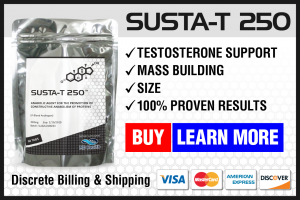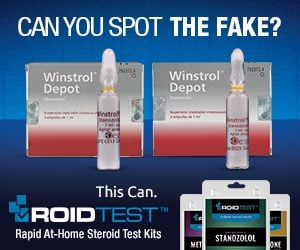Although Testosterone itself may present side effects that other modified analogues and derivatives have avoided (such as Estrogenic side effects, for example), Testosterone overall is considered the safest anabolic steroid if only for the reason that it is the anabolic hormone that the human body endogenously produces naturally. It then stands to reason that the human body is well accustomed to the effects of Testosterone on its cells and systems, and enough research has been conducted on Testosterone and its effects on the body that nearly all of the knowledge of Testosterone Propionate side effects possible are known to man, and this information is easily accessible. There is in fact far more abundant solid scientific data in the form of clinical studies and information on Testosterone and its different ester types than any other anabolic steroid in existence.
This is in contrast with other modified analogues of Testosterone. While as mentioned above, these modified analogues may avoid certain side effects that are inherently a part of Testosterone itself, they often may exhibit odd side effects and odd behavior unknown to science due to its modifications that essentially create an entirely new anabolic steroid. This odd behavior would never be exhibited by Testosterone itself, being that Testosterone being the most natural anabolic steroid to the human body. The hidden or odd side effects associated with various analogues/derivatives should therefore not be experienced with Testosterone (compared to a very mysterious compound, such as Anadrol or Trenbolone, for example).
With this having been established, Testosterone is not without its share of potential side effects. But it is our almost complete understanding of this compound that allows Testosterone Propionate side effects to be efficiently understood and dealt with.
Estrogenic Side Effects
Testosterone itself possesses a moderate level of Estrogenic activity, whereby it holds a moderate affinity to bind to the aromatase enzyme (the enzyme responsible for the conversion of Testosterone into Estrogen). Therefore, a moderate level of aromatization is to be expected with Testosterone use. The result can be significant rises in Estrogen levels resulting from the conversion of Testosterone into Estrogen, especially when Testosterone Propionate it utilized at bodybuilding doses and doses required for performance and physique enhancement. Estrogenic Testosterone Propionate side effects should not be ignored for this reason, and the rate of aromatization usually always holds a direct correlation with the doses utilized. It stands to reason that increasingly higher doses will usually be met with an increase in aromatization of Testosterone into Estrogen. Individuals should then understand that bodybuilding doses of Testosterone will often generate significant amounts of aromatization that must be dealt with in some way. Individuals can elect to use an aromatase inhibitor, which serves to disable the aromatase enzyme so that Testosterone cannot be converted into Estrogen, effectively controlling Estrogen increases as the root cause. The other possible option is the use of a SERM (Selective Estrogen Receptor Modulator) such as Nolvadex, which instead acts to block Estrogen from attaching to receptor sites in breast tissue. SERMs such as Nolvadex will only serve to remedy the issue of gynecomastia caused by Estrogen, and will not actually reduce serum Estrogen levels in the body – an aromatase inhibitor is what is required for such an effect. Estrogenic side effects include the following: water retention and bloating, blood pressure elevations (as a result of the water retention), increased possible fat retention/gain, and gynecomastia.
Androgenic Side Effects
Being that Testosterone is the prime male androgen, Testosterone Propionate side effects do include the aspect of androgenic side effects as well. It also undergoes conversion into an even stronger androgenic metabolite, Dihydrotestosterone (DHT). Testosterone possesses an androgenic strength rating of 100, which serves to exhibit a considerable amount of androgenic activity in the body. However, Testosterone Propionate side effects in the area of androgenicity have more to do with the fact that Testosterone is converted into the aforementioned stronger and more potent androgen Dihydrotestosterone (DHT) via the 5-alpha reductase (5AR) enzyme.
The 5-alpha reductase enzyme is present in large amounts in certain tissues, such as the scalp, prostate, and the skin. When Testosterone reaches these tissues, it undergoes a high rate of reduction into its more potent androgenic metabolite DHT. It is DHT that is responsible for the greater severity of androgenic side effects. Ancillary drugs such as Proscar or Dutasteride can be utilized to effectively inhibit the 5-alpha reductase enzyme and thereby eliminate DHT at the root of its cause. This will not, however, completely eliminate androgenic side effects due to the fact that Testosterone itself possesses an androgenic strength rating of 100 and will still act as an androgen in various tissues throughout the body even if the potential to convert into DHT is eliminated or reduced.
An alternative (or an adjunct) to 5AR inhibitors such as Proscar is the topical use of Nizoral 2% shampoo, where its active ingredient Ketoconazole acts as a topical DHT blocker in skin and scalp, effectively reducing the probability of androgens triggering male pattern baldness as well as acne breakouts caused by increased oily skin. Androgenic side effects include: increased sebum secretion (oily skin), increased bouts of acne (linked to increased sebum secretion), bodily and facial hair growth, benign prostatic hypertrophy (BPH), and the increased risk of triggering Male Pattern Baldness (MPB) in individuals that possess the genetic trait required for the condition to manifest itself.
HPTA and Endogenous Testosterone Production Side Effects
All anabolic steroids will cause the well-known and well-documented side effect of endogenous Testosterone production suppression and/or shutdown. Testosterone Propionate side effects are no exception to this rule for each and every anabolic steroid in existence. Possible complete and permanent shut-down of these endocrine systems can result as well, especially resultant from excessively long cycle lengths. Following the end of any cycle, a thorough and proper Post Cycle Therapy (PCT) program is always necessary, where Testosterone-stimulating ancillary compounds such as Nolvadex and/or HCG should be utilized in order to facilitate the normalization of the HPTA and endogenous Testosterone production as quickly as possible. PCT protocols and programs are usually run for the duration of 4 – 6 weeks after all anabolic steroids have cleared from the body following the end of the cycle. Failure to engage in a proper PCT program can result in permanent damage to the HPTA, whereby the individual produces insufficient/deficient levels of Testosterone (a medical condition known as hypogonadism), and medical treatment in the form of TRT (Testosterone Replacement Therapy) for life will be required.
Hepatotoxic Side Effects
Testosterone Propionate is not a C17-alpha alkylated anabolic steroid and therefore does not exhibit any measure of toxicity on the liver. The assurance of this fact rests in the studies that have investigated the potential for hepatotoxicity with Testosterone used at high doses (400mg daily, which equates to 2,800mg weekly) in several male test subjects for a 20 day period where the route of administration was actually oral instead of intramuscular injections. The idea in administering it orally rather than the traditional intramuscular injection is to saturate the liver with high amounts of Testosterone (all orally ingested substances make what is known as a ‘first pass’ through the liver and interact with the liver at a far greater rate than the injectable route of administration). The result of the study was that no changes were observed[1]. It is also important to note that even if there were any measure of hepatotoxicity with Testosterone Propionate, its route of administration lies in injection, which avoids the aforementioned first pass through the liver (something that only occurs with oral ingestion of a substance). Therefore, hepatotoxicity is not of any concern where Testosterone Propionate side effects are concerned.
Cardiovascular Side Effects
Cardiovascular strain and negative cholesterol changes are all peripheral effects that fall under Testosterone Propionate side effects. It is one side effect that is exhibited by every single anabolic steroid in existence and is inherent to the nature of anabolic steroids, especially oral anabolic steroids. This involves the reduction of HDL (the good cholesterol) and increases of LDL (the bad cholesterol). The result of such changes involves an increased risk of arteriosclerosis, and the degree to which these changes occur for the worse are usually dose-dependent (with higher doses increasing the negative changes and the risks). Other factors that affect these negative cholesterol changes are: duration of use, and route of administration. Testosterone itself actually happens to exhibit far less of an impact on cholesterol values in this case than all other anabolic steroids, as one of the contributing factors in this case is due to the liver’s ability to freely metabolize Testosterone, and the fact that Testosterone is not extremely resistant to hepatic breakdown and metabolism. The issue where hepatotoxicity is concerned mostly stems from certain anabolic steroids that possess the trait of exhibiting heavier resistance to hepatic metabolism than Testosterone is. This is one of the main reasons as to why oral anabolic steroids exhibit varying levels of hepatotoxicity – the C17-alpha alkylation causes the anabolic steroid to become further resistant to being metabolized or broken down by the liver. The concern as to whether an anabolic steroid has a high resistance to hepatic metabolism or a low resistance is a factor in how much impact a given anabolic steroid has on the liver’s management of cholesterol .
Testosterone in particular has demonstrated in one clinical study to have only a mild impact on HDL cholesterol after a 12 week period where 280mg of Testosterone Enanthate was administered weekly. The cholesterol profiles had later changed for the worse when an aromatase inhibitor was included, which resulted in a significant 25% drop in HDL cholesterol[2]. Conversely, other studies have been conducted whereby 300mg weekly of Testosterone Enanthate was administered for a 20 week period without the use of an aromatase inhibitor which resulted in a 13% reduction of HDL cholesterol, however, when Testosterone doses were raised to 600mg weekly, reduction of HDL cholesterol had dropped to 21%[3]. From the data examined, it is very evident that the increase in Estrogen via aromatization and liver metabolism actually helps to offset the negative cholesterol changes from the use of supraphysiological amounts of anabolic steroids. This makes sense, considering Estrogen itself is known to promote positive impacts on cholesterol levels. Therefore, the use of an aromatase inhibitor and its impact on cholesterol profiles should always be remembered when any user is considering the addition of an aromatase inhibitor on cycle.
It is therefore advisable to instead use minimal doses of an aromatase inhibitor while on a cycle for the purpose of Estrogen control rather than total Estrogen level elimination. The idea in such a case is to keep Estrogen levels within normal ranges and not allow them to skyrocket as a result of aromatization, but at the same time prevent them from dropping to near zero from the use of full doses of an aromatase inhibitor.
Testosterone Propionate References:
[1] Enzyme induction by oral testosterone. Johnsen SG, Kampmann JP, Bennet EP, Jorgensen F. 1976 Clin Pharmacol Ther 20:233-237






